
| Version | Summary | Created by | Modification | Content Size | Created at | Operation |
|---|---|---|---|---|---|---|
| 1 | Ashutosh Pareek | -- | 3823 | 2023-02-12 15:35:23 | | | |
| 2 | Jessie Wu | Meta information modification | 3823 | 2023-02-13 06:15:30 | | | | |
| 3 | Jessie Wu | -1 word(s) | 3822 | 2023-02-13 06:17:18 | | |
Video Upload Options
Moringa oleifera (M. oleifera), the “miracle tree”, thrives globally in almost all tropical and subtropical regions, but it is believed to be native to Afghanistan, Bangladesh, India, and Pakistan. The Moringa family comprises 13 species (M. oleifera, M. arborea, M. rivae, M. ruspoliana, M. drouhardii, M. hildebrandtii, M. concanensis, M. borziana, M. longituba, M. pygmaea, M. ovalifolia, M. peregrina, M. stenopetala), of which M. oleifera has become well known for its use in nutrition, biogas production, fertilizer, etc. Moringa has the unique property of tolerating drought. Studies have shown that M. oleifera is among the cheapest and most reliable alternatives for good nutrition. Nearly all parts of the tree are used for their essential nutrients. M. oleifera leaves have a high content of beta-carotene, minerals, calcium, and potassium. Dried leaves have an oleic acid content of about 70%, which makes them suitable for making moisturizers. The powdered leaves are used to make many beverages, of which “Zija” is the most popular in India. The bark of the tree is considered very useful in the treatment of different disorders such as ulcers, toothache, and hypertension. Roots, however, are found to have a role in the treatment of toothache, helminthiasis, and paralysis. The flowers are used to treat ulcers, enlarged spleen, and to produce aphrodisiac substances. The tree is believed to have incredible properties in treating malnutrition in infants and lactating mothers.
1. Ethnomedicinal/Traditional Properties
| Name of Ayurvedic Text | Form of Plant Used | Treatment | References |
|---|---|---|---|
| Charaka Samhita (1000 BC- 4th Cent. AD) |
Powder Decoction |
Used for treatment of worms and headache, Ascites, edema Hiccough and asthma, deafness, tinnitus in the ear, worm’s manifestation. |
[22] |
| Ashtanga Hridaya (7th Cent. AD) |
Oil | Ear ache, deafness, and tinnitus in the ear | [23] |
| Kashyapa Samhita (6–7th Cent AD) |
Decoction Oil |
Puerperal disorder, sleeplessness Edema |
[24] |
| Sharangadhara Samhita (13 Cent. AD) |
Decoction | Conjunctivitis | [25] |
| Yogaratnakara (17th Cent. A.D.) |
Decoction | Enlargement of spleen, worm edema, Ascites, fever, abscess. |
[26] |
2. Pharmacological Uses
| Plant Part | Compound | Class | Structure | Therapeutic Activity | References |
| Leaves | Rutin (555.6 µg/g) |
Flavonoid | 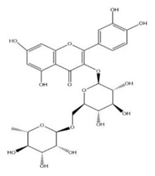 |
Found to have maximum affinity and interaction towards BRAC-1 gene. |
[33][34] |
| Leaves | Kaempferol (197.6 µg/g) |
Flavonoid | 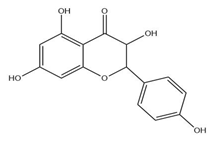 |
Oxidative damage protective activity. | [35] |
| Leaves | Quercetin (2030.9 µmol/100 g) |
Flavonoid | 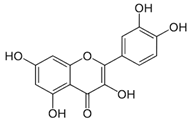 |
Exerts an excellent effect as anti-diabetic agent. | [36] |
| Leaves | O coumaric acid (0.536 mg/g) |
Phenolic acid | 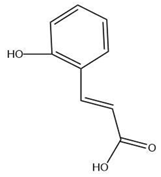 |
Antioxidant and anti-microbial | [37][38] |
| Leaves | Myricetin (5.804 mg/g) |
Flavonoid | 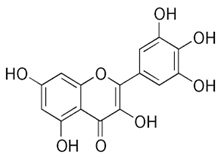 |
Potential prevention of diabetes mellitus and other diabetic complications | [38] |
| Leaves | Ellagic acid (0.078 to 0.128 mg/g) |
Polyphenol | 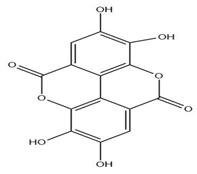 |
Prevents viral and bacterial infections, potential antioxidant |
[38][39] |
| Leaves | Ferulic acid (0.078 to 0.128 mg/g) |
Phenol | 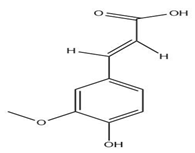 |
Promising results as anti- cancer, antioxidant, antithrombotic, anti-arrhythmic, and anti-inflammatory. |
[38][40] |
| Leaves | Caffeic acid (0.409 mg/g) |
Phenol | 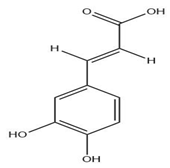 |
Boosts athletic performance, reduces fatigue, helps weight loss, protects against herpes, HIV, cancer. | [38][41] |
| Leaves | Sinapic acid (trace amount) |
Phenol | 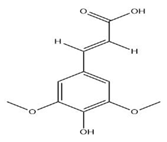 |
Cardioprotective, renoprotective, anxiolytic, neuroprotective. | [38][42] |
| Leaves | Gallic acid (1.034 mg/g) |
Phenol | 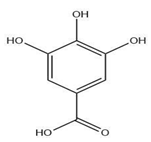 |
Anti-inflammatory, anti-neoplastic, anti-oxidant |
[38][43] |
| Leaves | Syringic acid (trace amount) |
Phenol | 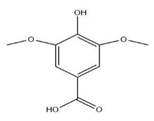 |
Anti-oxidant, antimicrobial. | [38][44] |
| Leaves | Isorhamnetin (0.118 mg/g) |
Flavonoid | 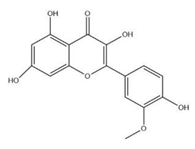 |
Anti-oxidant | [38][45] |
| Seeds | Myricetin (5.804 mg/g) |
Flavonoid | 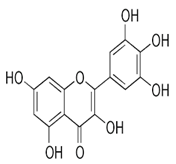 |
Potential prevention of diabetes mellitus and other diabetic complications | [38] |
| Seeds | Glucomoringin | Glucosinolates | 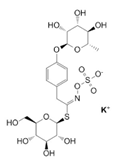 |
Anti-inflammatory, pain relieving, anti-oxidant, antihypertensive. |
[46] |
| Seeds | β-sitosterol | Phytosterol | 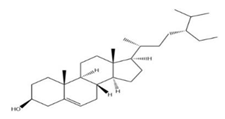 |
Anti-inflammatory | [47] |
| Seeds | Arachidic acid | Fatty acid | 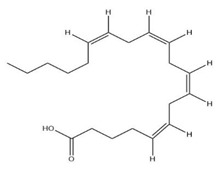 |
Increased breast milk production | [48] |
| Seeds | Oleic acid (70% w/w) | Fatty acid |  |
Reduces blood pressure and reduces free radical damage to the cell. |
[49] |
| Seeds | Myristic acid | Fatty acid |  |
Anxiolytic effect, used in membrane localization of the enzyme. |
[50] |
| Seeds | Palmitic acid | Fatty acid |  |
Trypanocidal and anti-leukemic effect | [51] |
| Seeds | Procyaniadin | Flavonoid | 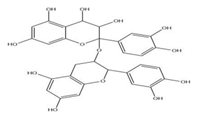 |
Cardioprotective | [52] |
| Flower | D-mannose | Carbohydrate | 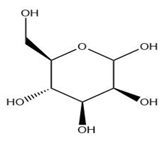 |
Treatment of deficiency caused by genetic defects, and acute urinary tract infections. |
[53] |
| Stem | β-sitosterol | Phytosterol | 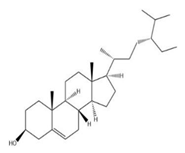 |
Anti-oxidant, cardiovascular, immunomodulatory |
[47] |
2.1. Antimicrobial and Antifungal Activity
2.2. Anti-Inflammatory Activity

2.3. Oxidative Stress
2.4. Anti-Oxidant Activity
2.5. Anti-Cancer Activity
2.6. Fertility and Anti-Fertility Activity
2.7. Hepatoprotective Activity
2.8. Cardiovascular Activity
2.9. Anti-Ulcer/Gastroprotective Activity
2.10. Analgesic/Antipyretic Activity
2.11. Neuropharmacological Activity

2.12. Neuropathic Pain
2.13. Wound Healing Effect
2.14. Immunomodulatory Activity
2.15. Hematological Activity
2.16. Anti-Obesity Activity

2.17. Anti-Allergic Activity
2.18. Anti-Diabetic Activity
2.19. Diuretic Activity
2.20. Angiotensin Converting Enzyme (ACE) Activity
2.21. Anti-Venom Effect
2.22. Cytotoxicity Effect
References
- Stohs, S.J.; Hartman, M.J. Review of the Safety and Efficacy of Moringa oleifera. Phytother. Res. 2015, 29, 796–804.
- Aekthammarat, D.; Pannangpetch, P.; Tangsucharit, P. Moringa oleifera leaf extract lowers high blood pressure by alleviating vascular dysfunction and decreasing oxidative stress in L-NAME hypertensive rats. Phytomedicine 2019, 54, 9–16.
- Bhat, S.K.; Joy, A.E. Antianxiety effect of ethanolic extract of leaves of Moringa oleifera in Swiss albino mice. Arch. Med. Health Sci. 2014, 2, 5–7.
- Misra, A.; Srivastava, S.; Srivastava, M. Evaluation of antidiarrheal potential of Moringa oleifera (Lam.) leaves. J. Pharmacogn. Phytochem. 2014, 2, 43–46.
- Tahkur, R.S.; Soren, G.; Pathapati, R.M.; Buchineni, M. Diuretic activity of Moringa oleifera leaves extract in swiss albino rats. J. Pharm. Innov. 2016, 5, 8–10.
- Woldeyohannes, M.G.; Eshete, G.T.; Abiye, A.A.; Hailu, A.E.; Huluka, S.A.; Tadesse, W.T. Antidiarrheal and Antisecretory Effect of 80% Hydromethanolic Leaf Extract of Moringa stenopetala Baker f. in Mice. Biochem. Res. Int. 2022, 2022, 2090–2247.
- Zhang, Y.; Peng, L.; Li, W.; Dai, T.; Nie, L.; Xie, J.; Ai, Y.; Li, L.; Tian, Y.; Sheng, J. Polyphenol Extract of Moringa oleifera Leaves Alleviates Colonic Inflammation in Dextran Sulfate Sodium-Treated Mice. Evid. Based Complement. Altern. Med. 2020, 2020, 6295402.
- Posmontier, B. The medicinal qualities of Moringa oleifera. Holist. Nurs. Pr. 2011, 25, 80–87.
- Gopalakrishnan, L.; Doriya, K.; Kumar, D.S. Moringa oleifera: A review on nutritive importance and its medicinal application. Food Sci. Hum. Wellness 2016, 5, 49–56.
- Karadi, R.V.; Gadge, N.B.; Alagawadi, K.R.; Savadi, R.V. Effect of Moringa oleifera Lam. root-wood on ethylene glycol induced urolithiasis in rats. J. Ethnopharmacol. 2006, 105, 306–311.
- Ghasi, S.; Nwobodo, E.; Ofili, J.O. Hypocholesterolemic effects of crude extract of leaf of Moringa oleifera Lam in high-fat diet fed wistar rats. J. Ethnopharmacol. 2000, 69, 21–25.
- Paliwal, R.; Sharma, V.; Pracheta. A Review on Horse Radish Tree (Moringa oleifera): A Multipurpose Tree with High Economic and Commercial Importance. Asian J. Biotechnol. 2011, 3, 317–328.
- Debnath, S.; Guha, D. Role of Moringa oleifera on enterochromaffin cell count and serotonin content of experimental ulcer model. Indian J. Exp. Biol. 2007, 45, 726–731.
- Mahajan, S.G.; Mali, R.G.; Mehta, A.A. Protective Effect of Ethanolic Extract of Seeds of Moringa oleifera Lam. Against Inflammation Associated with Development of Arthritis in Rats. J. Immunotoxicol. 2007, 4, 39–47.
- Rathi, B.S.; Bodhankar, S.L.; Baheti, A.M. Evaluation of aqueous leaves extract of Moringa oleifera Linn for wound healing in albino rats. Indian J. Exp. Biol. 2006, 44, 898–901.
- Bhattacharya, A.; Tiwari, P.; Sahu, P.K.; Kumar, S. A review of the phytochemical and pharmacological characteristics of Moringa oleifera. J. Pharm. Bioallied Sci. 2018, 10, 181–191.
- Pandey, A.; Pandey, R.D.; Tripathi, P.; Gupta, P.P.; Haider, J.; Bhatt, S.; Singh, A.V. Moringa oleifera Lam. (Sahijan)—A plant with a plethora of diverse therapeutic benefits: An Updated Retrospection. Int. J. Med. Aromat. 2012, 1, 1–8.
- Meireles, D.; Gomes, J.; Lopes, L. A review of properties, nutritional and pharmaceutical applications of Moringa oleifera: Integrative approach on conventional and traditional Asian medicine. Adv. Tradit. Med. 2020, 20, 495–515.
- Liu, W.L.; Wu, B.F.; Shang, J.H.; Wang, X.F.; Zhao, Y.L.; Huang, A.X. Moringa oleifera seed ethanol extract and its active component kaempferol potentiate pentobarbital-induced sleeping behaviours in mice via a GABAergic mechanism. Pharm. Biol. 2022, 60, 810–824.
- Gothai, S.; Arulselvan, P.; Tan, W.S.; Fakurazi, S. Wound healing properties of ethyl acetate fraction of Moringa oleifera in normal human dermal fibroblasts. J. Intercult. Ethnopharmacol. 2016, 5, 1–6.
- Toma, A.; Deyno, S. Phytochemistry and pharmacological activities of Moringa oleifera. Indian, J. Pharmacol. 2014, 4, 222–231.
- Tripathi, B. Charaka Samhita, of Agnivesa, 3rd ed.; Chaukambha Surbharati Prakashan: Varanasi, India, 1994; pp. 15–20.
- Gupta, K.A. Astanga Hridaya, 13th ed.; Chaukambha Sanskrit Sansthan: Varanasi, India, 2000; pp. 5–17.
- Sharma, H.R. Kashyap Samhita, 3rd ed.; Chaukhambha Sanskrit Sansthan: Varanasi, India, 2010; pp. 2–4.
- Srikanthmurthy, K.R. SharangadharaSamhita, 12th ed.; Master Kheladi Lal and Sons: Benaras City, India, 1933; pp. 14–20.
- Laksmipati, V.S. Yogaratnakara, 7th ed.; Chaukambha Sanskrit Sansthan: Varanasi, India, 1999; pp. 1–5.
- Mishra, G.; Singh, P.; Verma, R.; Kumar, S.; Srivastav, S.; Jha, K.K.; Khosa, R.L. Traditional uses, phytochemistry and pharmacological properties of Moringa oleifera plant: An overview. Der Pharmacia Lett. 2011, 3, 141–164.
- Upadhyay, P.; Yadav, M.K.; Mishra, S.; Sharma, P.; Purohit, S. Moringa oleifera: A review of the medical evidence for its nutritional and pharmacological properties. Int. J. Res. Pharm. Sci. 2015, 5, 12–16.
- Singh, A.; Navneet. Ethnomedicinal, pharmacological and antimicrobial aspects of Moringa oleifera lam.: A review. J. Phytopharmacol. 2018, 7, 45–50.
- Banik, S.; Biswas, S.; Karmakar, S. Extraction, purification, and activity of protease from the leaves of Moringa oleifera. F1000Research 2018, 7, 1151.
- Parvathy, M.V.S.; Umamaheshwari, A. Cytotoxic Effect of Moringa oleifera Leaf Extracts on Human Multiple Myeloma Cell Lines. Trends Medical Res. 2007, 2, 44–50.
- Venkatesh, N.; Devi, K.G.; Venkateswarlu, G.; Sudhakar, A.M.S. effect of hydroalcoholic extract of Moringa oleifera leaves on fertility hormone and sperm quality of male albino rats. Int. J. Curr. Med. Pharm. Res. 2019, 1, 83–87.
- Balogun, T.A.; Buliamimu, K.D.; Chukwudozie, O.S.; Tiamiyu, Z.A.; Idowu, T.J. Anticancer Potential of Moringa oleifera on BRCA-1 Gene: Systems Biology. Bioinform. Biol. Insights. 2021, 15, 11779322211010703.
- Alam, P.; Elkholy, S.F.; Mahfouz, S.A.; Alam, P.; Sharaf-Eldin, M.A. HPLC based estimation and extraction of rutin, quercetin and gallic acid in Moringa oleifera plants grown in Saudi Arabia. J. Chem. Pharm. 2016, 8, 1243–1246.
- Singh, B.N.; Singh, B.R.; Singh, R.L. Oxidative DNA damage protective activity, antioxidant and anti-quorum sensing potentials of Moringa oleifera. Food Chem. Toxicol. 2009, 47, 1109–1116.
- Ndong, M.; Uehara, M.; Katsumata, S.; Suzuki, K. Effects of oral administration of Moringa oleifera Lam on glucose tol-erance in Goto-Kakizaki and Wistar rats. J. Clin. Biochem. Nutri. 2007, 40, 229–233.
- Zhang, M.; Hettiarachchy, S.N.; Horax, R.; Kannan, A.; Praisoody, M.D.A.; Muhundan, A.; Mallangi, C.R. Phytochemicals, antioxidant and antimicrobial activity of Hibiscus sabdariffa, Centella asiatica, Moringa oleifera and Murraya koenigii leaves. J. Med. Plants Res. 2011, 5, 6672–6680.
- Leone, A.; Spada, A.; Battezzati, A.; Schiraldi, A.; Aristil, J.; Bertoli, S. Cultivation, genetic, ethnopharmacology, phytochemistry and pharmacology of Moringa oleifera leaves: An overview. Int. J. Mol. Sci. 2015, 16, 12791–12835.
- Sharifi-Rad, J.; Quispe, C.; Castillo, C.M.S.; Caroca, R.; Lazo-Vélez, M.A.; Antonyak, H.; Polishchuk, A.; Lysiuk, R.; Oliinyk, P.; Masi, L.D.; et al. Phytochemicals for the Prevention and Treatment of Oxidative Stress-Induced Diseases. World J. Gastrointest. Endosc. 2022, 22, 1–9.
- Zduńska, K.; Dana, A.; Kolodziejczak, A.; Rotsztejn, H. Antioxidant Properties of Ferulic Acid and Its Possible Application. Skin Pharmacol. Physiol. 2018, 31, 332–336.
- Chung, T.W.; Moon, S.K.; Chang, Y.C.; Ko, J.H.; Lee, Y.C.; Cho, G.; Kim, S.H.; Kim, J.G.; Kim, C.H. Novel and therapeutic effect of caffeic acid and caffeic acid phenyl ester on hepatocarcinoma cells: Complete regression of hepatoma growth and metastasis by dual mechanism. FASEB J. 2004, 18, 1670–1681.
- Pandi, A.; Kalappan, V.M. Pharmacological and therapeutic applications of Sinapic acid—An updated review. Mol. Biol. Rep. 2021, 48, 3733–3745.
- Alhakmani, F.; Kumar, S.; Khan, S.A. Estimation of total phenolic content, in-vitro antioxidant and anti-inflammatory activity of flowers of Moringa oleifera. Asian Pac. J. Trop. Biomed. 2013, 3, 623–627.
- Bennour, N.; Mighri, H.; Eljani, H.; Zammouri, T.; Akrout, A. Effect of Solvent Evaporation Method on Phenolic Compounds and the Antioxidant Activity of Moringa oleifera Cultivated in Southern Tunisia. S. Afr. J. Bot. 2020, 129, 181–190.
- Riaz, A.; Rasul, A.; Hussain, G.; Zahoor, M.K.; Jabeen, F.; Subhani, Z.; Younis, T.; Ali, M.; Sarfraz, I.; Selamoglu, Z. Astragalin: A Bioactive Phytochemical with Potential Therapeutic Activities. Adv. Pharmacol. Sci. 2018, 2018, 9794625.
- Borgonovo, G.; De Petrocellis, L.; Schiano Moriello, A.; Bertoli, S.; Leone, A.; Battezzati, A.; Mazzini, S.; Bassoli, A. Moringin, A Stable Isothiocyanate from Moringa oleifera, activates the Somatosensory and Pain Receptor TRPA1 Channel In Vitro. Molecules 2020, 25, 976.
- Liao, P.-C.; Lai, M.-H.; Hsu, K.-P.; Kuo, Y.-H.; Chen, J.; Tsai, M.-C.; Li, C.-X.; Yin, X.-J.; Jeyashoke, N.; Chao, L.K.-P. Identification of β-Sitosterol as in Vitro Anti-Inflammatory Constituent in Moringa oleifera. J. Agric. Food Chem. 2018, 66, 10748–10759.
- Sari, K.; Sirajuddin, S.; Maddeppungeng, M.; Hadju, V.; Saleh, A.; Hastuti, H. Moringa oleifera Intake during Pregnancy and Breastfeeding toward Docosahexaenoic Acid and Arachidonic Acid Levels in Breast Milk. Open Access Maced. J. Med. Sci. 2020, 8, 757–761.
- Snehal, M.; Parag, G.; Jyotsna, W.; Satyanarayan, N.N. Intensified synthesis of structured lipids from oleic acid rich moringa oil in the presence of supercritical CO2. Food Bioprod. Process. 2020, 112, 86–95.
- Kaur, G.; Invally, M.; Sanzagiri, R.; Buttar, H.S. Evaluation of the antidepressant activity of Moringa oleifera alone and in combination with fluoxetine. J. Ayurveda Integr. Med. 2015, 6, 273–279.
- Korbecki, J.; Bajdak-Rusinek, K. The effect of palmitic acid on inflammatory response in macrophages: An overview of molecular mechanisms. Inflamm. Res. 2019, 68, 915–932.
- Rue, E.A.; Rush, M.D.; Van Breemen, R.B. Procyanidins: A comprehensive review encompassing structure elucidation via mass spectrometry. Phytochem. Rev. 2018, 17, 1–16.
- Maurya, S.K.; Singh, A.K. Clinical Efficacy of Moringa oleifera Lam. Stems Bark in Urinary Tract Infections. Int. Sch. Res. Not. 2014, 2014, 906843.
- Padla, E.P.; Solis, L.T.; Levida, R.M.; Shen, C.C.; Ragasa, C.Y. Antimicrobial isothiocyanates from the seeds of Moringa oleifera Lam. Z. Für Nat. C 2012, 67, 557–564.
- Ahmadua, T.; Ahmad, K.; Ismail, S.I.; Rashed, O.; Asib, N.; Omar, D. Antifungal efficacy of moringa oliefera leaves and seed extract against Botrytis cinerea causing graymold disease of tomato. Braz. J. Biol. 2020, 81, 1007–1022.
- Moodley, J.S.; Krishna, S.B.N.; Pillay, K. Green synthesis of silver nanoparticles from Moringa oleifera leaf extracts and its antimicrobial potential. Adv. Nat. Sci. Nanosci. Nanotechnol. 2018, 9, 1–10.
- Dinesha, B.L.; Nidoni, U.; Ramachandra., C.T.; Naik, N.; Sankalpa, K.B. Effect of extraction methods on physicochemical, nutritional, antinutritional, antioxidant and antimicrobial activity of Moringa (Moringa oleifera Lam.) seed kernel oil. J. Appl. Nat. Sci. 2018, 10, 287–295.
- Anzano, A.; De Falco, B.; Ammar, M.; Ricciardelli, A.; Grauso, L.; Sabbah, M.; Capparelli, R.; Lanzotti, V. Chemical Analysis and Antimicrobial Activity of Moringa oleifera Lam. Leaves and Seeds. Molecules 2022, 27, 8920.
- Tan, W.S.; Arulselvan, P.; Karthivashan, G.; Fakurazi, S. Moringa oleifera Flower Extract Suppresses the Activation of Inflammatory Mediators in Lipopolysaccharide-Stimulated RAW 264.7 Macrophages via NF-κB Pathway. Mediators Inflamm. 2015, 2015, 720171.
- Cuellar-Núñez, M.L.; Gonzalez de Mejia, E.; Loarca-Piña, G. Moringa oleifera leaves alleviated inflammation through downregulation of IL- 2, IL- 6, and TNF- α in a colitis associated colorectal cancer model. Int. Food Res. J. 2021, 144, 110318.
- Abdel-Daim, M.M.; Khalil, S.R.; Awad, A.; Abu Zeid, E.H.; El-Aziz, R.A.; El-Serehy, H.A. Ethanolic Extract of Moringa oleifera Leaves Influences NF-κB Signaling Pathway to Restore Kidney Tissue from Cobalt-Mediated Oxidative Injury and Inflammation in Rats. Nutrients 2020, 12, 1031.
- Choi, E.J.; Debnath, T.; Tang, Y.; Ryu, Y.B.; Moon, S.H.; Kim, E.K. Topical application of Moringa oleifera leaf extract ameliorates experimentally induced atopic dermatitis by the regulation of Th1/Th2/Th17 balance. Biomed. Pharmacother. 2016, 84, 870–877.
- Soliman, M.M.; Al-Osaimi, S.H.; Hassan Mohamed, E.; Aldharani, A.; Alkhedaide, A.; Althobaiti, F.; Mohamed, W.A. Protective effects of Moringa oleifera Leaf Extract against Methotrexate-Induced Oxidative Stress and Apoptosis on Mouse Spleen. Evid. -Based Complement. Altern. Med. 2020, 2020, 6738474.
- Zhou, Y.; Yang, W.; Li, Z.; Luo, D.; Li, W.; Zhang, Y.; Wang, X.; Fang, M.; Chen, Q.; Jin, X. Moringa oleifera stem extract protect skin keratinocytes against oxidative stress injury by enhancement of antioxidant defense systems and activation of PPARα. Biomed. Pharmacother. 2018, 107, 44–53.
- El-Hadary, A.E.; Ramadan, M.F. Antioxidant traits and protective impact of Moringa oleifera leaf extract against diclofenac sodium-induced liver toxicity in rats. J. Food Biochem. 2019, 43, e12704.
- Nunthanawanich, P.; Sompong, W.; Sirikwanpong, S.; Mäkynen, K.; Adisakwattana, S.; Dahlan, W.; Ngamukote, S. Moringa oleifera aqueous leaf extract inhibits reducing monosaccharide-induced protein glycation and oxidation of bovine serum albumin. Springer Plus. 2016, 5, 1098.
- Albuquerque Costa, R.; de Sousa, O.V.; Hofer, E.; Mafezoli, J.; Barbosa, F.G.; Vieira, R. Thiocarbamates from Moringa oleifera Seeds Bioactive against Virulent and Multidrug-Resistant Vibrio Species. BioMed Res. Int. 2017, 2017, 7963747.
- Vergara-Jimenez, M.; Almatrafi, M.M.; Fernandez, M.L. Bioactive Components in Moringa oleifera Leaves Protect against Chronic Disease. Antioxidant 2017, 6, 91.
- Agrawal, N.D.; Nirala, S.K.; Shukla, S.; Mathur, R. Co-administration of adjuvants along with Moringa oleifera attenuates beryllium-induced oxidative stress and histopathological alterations in rats. Pharm. Biol. 2015, 53, 1465–1473.
- Sasikala, V.; Rooban, B.N.; Priya, S.G.; Sahasranamam, V.; Abraham, A. Moringa oleifera prevents selenite-induced cataractogenesis in rat pups. J. Ocul. Pharmacol. Ther. 2010, 26, 441–447.
- Vongsak, B.; Mangmool, S.; Gritsanapan, W. Antioxidant Activity and Induction of mRNA Expressions of Antioxidant Enzymes in HEK-293 Cells of Moringa oleifera Leaf Extract. Planta Med. 2015, 81, 1084–1089.
- Guevara, A.P.; Vargas, C.; Sakurai, H.; Fujiwara, Y.; Hashimoto, K.; Maoka, T.; Kozuka, M.; Ito, Y.; Tokuda, H.; Nishino, H. An antitumor promoter from Moringa oleifera Lam. Mutat. Res. 1999, 440, 181–188.
- Mohd Fisall, U.F.; Ismail, N.Z.; Adebayo, I.A.; Arsad, H. Dichloromethane fraction of Moringa oleifera leaf methanolic extract selectively inhibits breast cancer cells (MCF7) by induction of apoptosis via upregulation of Bax, p53 and caspase 8 expressions. Mol. Biol. Rep. 2021, 48, 4465–4475.
- Attah, A.F.; Moody, J.O.; Sonibare, M.A.; Salahdeen, H.H.; Akindele, O.O.; Nnamani, P.O.; Diyaolu, O.A.; Raji, Y. Aqueous extract of Moringa oleifera leaf used in Nigerian ethnomedicine alters conception and some pregnancy outcomes in Wistar rat. S. Afr. J. Bot. 2020, 129, 255–262.
- Sharifudin, S.A.; Fakurazi, S.; Hidayat, M.T.; Hairuszah, I.; Aris, M.; Moklas, M.; Arulselvan, P. Therapeutic potential of Moringa oleifera extracts against acetaminophen-induced hepatotoxicity in rats. Pharm. Biol. 2013, 51, 279–288.
- Hamza, A.A. Ameliorative effects of Moringa oleifera Lam seed extract on liver fibrosis in rats. Food Chem. Toxicol. 2010, 48, 345–355.
- Nandave, M.; Ojha, S.K.; Joshi, S.; Kumari, S.; Arya, D.S. Moringa oleifera leaf extract prevents isoproterenol-induced myocardial damage in rats: Evidence for an antioxidant, antiperoxidative, and cardioprotective intervention. J. Med. Food. 2009, 12, 47–55.
- Panda, S.; Kar, A.; Sharma, P.; Sharma, A. Cardioprotective potential of N,alpha-L-rhamnopyranosyl vincosamide, an indole alkaloid, isolated from the leaves of Moringa oleifera in isoproterenol induced cardiotoxic rats: In vivo and in vitro studies. Bioorganic Med. Chem. Lett. 2012, 23, 959–962.
- Ijioma, S.N.; Nwaogazi, E.N.; Nwankwo, A.A.; Oshilonya, H.; Ekeleme, C.M.; Oshilonya, L.U. Histological exhibition of the gastroprotective effect of Moringa oleifera leaf extract. Comp. Clin. Pathol. 2018, 27, 327–332.
- Mallya, R.; Chatterjee, P.K.; Vinodini, N.A.; Chatterjee, P.; Mithra, P. Moringa oleifera Leaf Extract: Beneficial Effects on Cadmium Induced Toxicities—A review. J. Clin. Diagn. Res. 2017, 11, CE01.
- Martínez-Gonzálezb, C.L.; Martíneza, L.; Martínez-Ortizb, E.J.; González-Trujanoa, M.E.; Déciga-Camposc, M.; Ventura-Martínezd, R.; Díaz-Revale, I. Moringa oleifera, a species with potential analgesic and anti-inflammatory activities. Biomed. Pharmacother. 2017, 87, 482–488.
- Mohan, M.; Kaul, N.; Punekar, A.; Girnar, R.; Junnare, P.; Patil, L. Nootropic activity of Moringa oleifera leaves. J. Nat. Remedies 2005, 5, 59–62.
- Amrutia, J.N.; Lala, M.; Srinivasa, U.; Shabaraya, A.R.; Semuel, M.R. Anticonvulsant activity of Moringa oleifera leaf. Int. Res. J. Pharm. 2011, 2, 160–162.
- Ray, K.; Guha, D. Effect of Moringa oleifera root extract on penicillin-induced epileptic rats. Biog. Amines 2005, 19, 223–231.
- Khongrum, J.; Wattanathorn, J.; Muchimapura, S.; Thukhum-mee, W.; Thipkaew, C.; Wannanon, P.; Tong-Un, T. Moringa oleifera Leaves Extract Attenuates Neuropathic Pain Induced by Chronic Constriction Injury. Am. J. Appl. Sci. 2012, 9, 1182–1187.
- Raafat, K.; Hdaib, F. Neuroprotective Effects of Moringa oleifera: Bio-guided GC-MS Identification of Active Compounds in Diabetic Neuropathic Pain Model. Chin. J. Integr. Med. 2017. Online ahead of print.
- Muhammad, A.A.; Arulselvan, P.; Cheah, P.S.; Abas, F.; Fakurazi, S. Evaluation of wound healing properties of bioactive aqueous fraction from Moringa oleifera Lam on experimentally induced diabetic animal model. Drug Des. Devel. Ther. 2016, 10, 1715–1730.
- Awodele, O.; Oreagba, I.A.; Odoma, S.; Jaime, A.; Da Silva, T.; Osunkalu, V.O. Toxicological evaluation of the aqueous leaf extract of Moringa oleifera Lam. (Moringaceae). J. Ethnopharmacol. 2012, 139, 330–336.
- Mehwish, H.M.; Rajoka, M.S.; Xiong, Y.; Zheng, K.; Xiao, H.; Liu, Z.; Zhu, Q.; He, Z. Moringa oleifera—A Functional Food and Its Potential Immunomodulatory Effects. Food Rev. Int. 2020, 38, 1533–1552.
- Suzana, D.; Suyatna, F.D.; Andrajati, R.; Sari, S.P.; Mun’im, A. Effect of Moringa oleifera leaves extract against hematology and blood biochemical value of patients with iron deficiency anaemia. J. Young Pharm. 2017, 9, 79–84.
- Bais, S.; Singh, G.S.; Sharma, R. Anti-obesity and hypolipidemic activity of Moringa oleifera leaves against high fat diet-induced obesity in rats. Adv Biol. 2014, 2014, 162914.
- Redha, A.A.; Perna, S.; Riva, A.; Petrangolini, G.; Peroni, G.; Nichetti, M.; Iannello, G.; Naso, M.; Faliva, M.A.; Rondanelli, M. Novel insights on anti-obesity potential of the miracle tree, Moringa oleifera: A systematic review. J. Funct. Foods 2021, 84, 104600.
- Al-maliki, A.; El Rabey, H.A. The Antidiabetic Effect of Low Doses of Moringa oleifera Lam. Seeds on Streptozotocin Induced Diabetes and Diabetic Nephropathy in Male Rats. Biomed Res. Int. 2015, 2015, 381040.
- Villarruel-López, A.; López-de la Mora, D.A.; Vázquez-Paulino, O.D.; Puebla-Mora, A.G.; Torres-Vitela, M.R.; Guerrero-Quiroz, L.A.; Nuño, K. Effect of Moringa oleifera consumption on diabetic rats. BMC Complement. Altern. Med. 2018, 18, 120–127.
- Azad, S.B.; Ansari, P.; Azam, S.; Hossain, S.M.; Shahid, M.I.; Hasan, M.; Hannan, J. Anti-hyperglycaemic activity of Moringa oleifera is partly mediated by carbohydrase inhibition and glucose-fibre binding. Biosci. Rep. 2017, 37, BSR20170059.
- Khan, H.; Jaiswal, V.; Kulshreshtha, S.; Khan, A. Potential Angiotensin Converting Enzyme Inhibitors from Moringa oleifera. Recent Patents Biotechnol. 2019, 13, 239–248.
- Khan, H.; Hussain, T.; Kataria, M.; Seth, A.; Malik, M.; Dash, A.; Chand, S.; Khan, M. Role of selective Bioactive Compounds as an Angiotensin Converting Enzyme Inhibitor. Res. Sq. 2020, 7, 1–25.
- Adeyi, A.O.; Ajisebiola, S.B.; Adeyi, E.O.; Alimba, C.G.; Okorie, U.G. Antivenom activity of Moringa oleifera leave against pathophysiological alterations, somatic mutation and biological activities of Naja nigricollis venom. Sci. Afr. 2020, 8, 68–76.
- Nayak, G.; Rao, A.; Mullick, P.; Mutalik, S.; Kalthur, S.G.; Adiga, S.K.; Kalthur, G. Ethanolic extract of Moringa oleifera leaves alleviate cyclophosphamide induced testicular toxicity by improving endocrine function and modulating cell specific gene expression in mouse testis. J Ethnopharmacol. 2020, 259, 112922.




